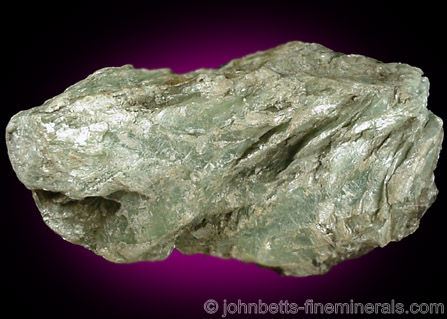The Mineral talc

Talc is known for being the softest mineral on earth. It is number 1 on the Mohs hardness scale, and can be easily scratched by a fingernail. Talc is not commonly seen in collections, as it is usually uninteresting and fairly common, although a few deeply colored and crystallized examples are known and well sought after. Also very popular are the Talc pseudomorphs. Talc forms some very interesting pseudomorphs after many different minerals, and certain localities are known for the specific minerals replaced by Talc.
Health concerns including a rare respiratory disease are known to be associated with Talc in its powder form. Although solid forms of Talc are assumed to be safe, and most concerns are only after prolonged exposure, it is advisable to wash hands after handling Talc.
Chemical Formula
Mg3Si4O10(OH)2
Color
White, beige, gray, yellow, brown, pink, purple, blue, green. Rarely colorless.
Crystal System
Monoclinic
Properties
Streak
White |
Hardness
1 |
Transparency
Transparent to opaque |
Specific Gravity
2.7 - 2.8 |
Luster
Greasy, waxy, pearly |
Cleavage
1,1 |
Fracture
Uneven |
Tenacity
Sectile |
Other ID Marks
1) Has a greasy feel.
2) May be lightly fluorescent.
|
Varieties
-
Rock formed mostly of Talc and with small amounts of Chlorite and pyroxenes. The term Soapstone may also be used to describe a massive form of Talc. Soapstone is used in ornamental carvings and tilings.
Uses
Talc is a very important industrial mineral. Talc is crushed into powder to form talcum powder, which is the main ingredient in many cosmetics as well as some baby powders. Talcum powder was also used as a filler to prevent slipping in latex gloves, although its use is being replaced with corn starch which is safer for inhalation. Talc is highly resistance to heat and electricity, and is therefore used in electronics and as an insulator. It is also a filler material for paints, rubber and insecticides.
Talc is also used as an ornamental stone, being carved into figures, jewelry boxes, tiling, and art sculptures. Since it is so soft, it is very easily cut and carved.
Noteworthy Localities
Talc is an important accessory mineral and can be found worldwide. Crystallized Talc in very small crystals comes from the Trimouns Talc Mine, Luzenac, France; and from Brosso, Lessolo, Italy. Excellent Talc pseudomorphs, especially after Quartz, are famous from the Johannes Mine in Göpfersgrün, Bavaria, Germany. Talc pseudomorphs after Enstatite come from Bamble, Telemark, Norway; and Talc pseudomorphs after Dolomite from the Respina Mine, Puebla de Lillo, Spain. Excellent Talc specimens and pseudomorphs come from Brumado, Bahia, Brazil.
In the U.S., are rare form of green crystallized Talc comes from the Vermont Verde Antique Quarry, Rochester, Windsor Co., Vermont. Windsor Co. also contains two other important Talc deposits at Chester and Ludlow. Good Talc also comes from the Serpentine belt on the State Line District of Pennsylvania and Maryland, especially at Pilot, Cecil Co., Maryland. In North Carolina, nice foliated green Talc comes from the Green Mountain Mine, Day Book, Yancey Co. In the Cyprus Mine, Ennis, Madison County, Montana, white Talc is found with black dendritic manganese oxide growths included in the Talc, and these are sometimes sawn into slab for collectors.
Distingushing Similar Minerals
Talc may be similar to some foliated forms of Serpentine, but its very low hardness can distinguish it.
Chlorite and the micas lack a greasy feel and are harder.